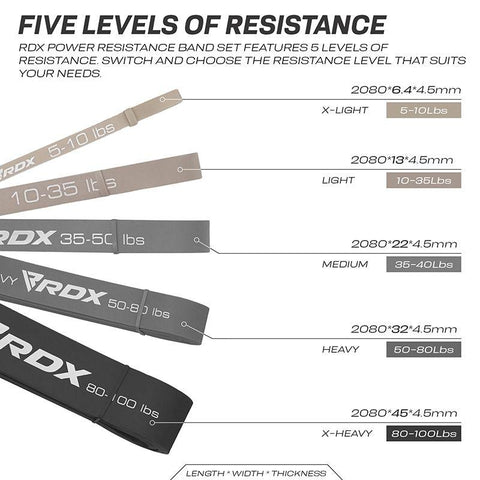Resistance Bands have taken over social media feeds and home workouts during the pandemic, but do the rubber bands truly deliver results? we have put together a post that will explore the effectiveness of resistance bands, exploring into the research and expert insights to determine if they live up to the hype. From muscle building to strength training, we will uncover the truth behind using resistance bands for fitness.
Types of Resistance Bands
Some of the most common types of resistance bands include therapy bands, loop bands, tube bands with handles, figure-eight bands, and ring resistance bands. Each type offers unique benefits and can be used for various exercises to strengthen different muscle groups. Any individual looking to incorporate resistance bands into their workout routine can choose the type that best suits their needs and fitness goals.
| Therapy Bands | Loop Bands |
|---|---|
Therapy BandsAssuming you are looking to improve mobility or recover from an injury, therapy bands can be an excellent choice. These bands offer gentle resistance and can be used for rehabilitation exercises to improve flexibility and strength. |
Loop BandsOn the other hand, loop bands are versatile and can be used for a wide range of exercises targeting various muscle groups. With different resistance levels available, loop bands are suitable for beginners and advanced users alike. |
| Tube Bands with Handles | Figure-Eight Bands | Ring Resistance Bands |
|---|---|---|
Tube Bands with HandlesClearly, tube bands with handles offer a convenient grip and allow for a greater range of motion during exercises. These bands are ideal for strength training and can target specific muscle groups effectively. |
Figure-Eight BandsYou can use figure-eight bands for upper and lower body exercises, providing resistance in multiple directions. To maximize results, incorporate figure-eight bands into your workout routine for increased muscle engagement and toning. |
Ring Resistance BandsWith ring resistance bands, you can perform a variety of functional movements to improve balance, stability, and overall strength. This type of band is particularly beneficial for enhancing core strength and coordination. |
Important Factors to Consider Before Using Resistance Bands
For those considering incorporating resistance bands into their workout routine, it's important to assess various factors to ensure effectiveness and safety. One key aspect to evaluate is your fitness level and goals. Bands of different resistance levels cater to individuals at various stages of fitness, making it imperative to choose the appropriate band for your needs. Knowing your goals, whether it's muscle building, strength training, or rehabilitation, will help determine the right resistance level to achieve desired results.

Fitness Level and Goals
Bands offer a versatile way to tailor workouts according to your fitness level and goals. Whether you are a beginner looking to build strength or an athlete aiming to enhance performance, selecting the right resistance level will ensure progress and prevent plateaus. Understanding how bands can cater to your specific goals will maximize the benefits of incorporating them into your fitness routine.
Space and Portability Requirements
Using resistance bands requires minimal space, making them ideal for home workouts or traveling. Their compact design allows for easy storage and portability, offering convenience for individuals with limited space or those constantly on the move. The versatility of bands also means you can perform a variety of exercises without the need for bulky equipment, providing a cost-effective and space-efficient option for strength training.
The convenience of resistance bands extends beyond their space-saving benefits. Being lightweight and easily transportable, they enable users to maintain their fitness regimen wherever they go, ensuring consistency in their workout routine. Those who value flexibility and convenience in their workouts will find resistance bands to be a valuable addition to their fitness arsenal.
Key Takeaways:
- Resistance bands are effective: Research shows that resistance-band exercises can provide similar strength gains to traditional weight training, benefiting both average individuals and athletes.
- Convenience and accessibility: Resistance bands are affordable, easy to use at home, and suitable for people of all fitness levels, making them a convenient option for building muscle and strength.
- Limitations compared to free weights: While resistance bands offer benefits, they have limitations such as inconsistent resistance throughout movements and the inability to adjust resistance easily like with free weights.
Injury History and Safety Precautions
Safety should be a top priority when incorporating resistance bands into your workouts. Assessing your injury history and considering any existing physical limitations is crucial to prevent exacerbating injuries or causing new ones. Understanding proper form and technique when using resistance bands is imperative to avoid strain or injury. By incorporating bands mindfully and gradually increasing resistance levels, users can minimize the risk of injuries and maximize the benefits of their workouts.
With proper knowledge of your body's limitations and precautions in place, resistance bands can be a safe and effective tool for strengthening muscles and improving overall fitness. Regularly checking in with your body and adjusting your workout routine accordingly will help you avoid potential injuries and make consistent progress in your fitness journey.
Combination with other Exercise Equipment
With the versatility of resistance bands, they can complement other exercise equipment for a more comprehensive workout routine. Combining bands with free weights or machines can provide a varied resistance training experience, targeting different muscle groups and enhancing overall strength. Understanding how to integrate resistance bands with other equipment will allow for a well-rounded workout that meets your fitness goals efficiently.

Step-by-Step Guide to Using Resistance Bands
| Selecting the Appropriate Band Resistance Level | Setting Up Your Exercise Space |
| If you are new to resistance band workouts, it is important to choose the right band resistance level to prevent injury and ensure effectiveness. Start with a lighter band and gradually increase the resistance as you build strength. | While setting up your exercise space, make sure you have enough room to move freely without any obstacles. Consider using a yoga mat or a non-slip surface to prevent the band from slipping during exercises. |
Plus, having a clear and clutter-free space will help you focus on your form and technique, reducing the risk of injuries during your resistance band workout.
Warm-Up and Stretching Exercises
| Resistance | Exercises |
| Before starting your resistance band workout, it is imperative to warm up your muscles to prevent strains and prepare your body for the exercises ahead. Perform dynamic stretches such as arm circles, leg swings, and torso twists to increase blood flow and flexibility. | Any resistance band workout should begin with proper warm-up and stretching exercises to improve performance and reduce the risk of injuries. Focus on targeting major muscle groups with dynamic movements to prepare your body for the workout. |
Basic Resistance Band Exercises
For instance, basic resistance band exercises like bicep curls, shoulder presses, and squats are a great way to target different muscle groups and build strength. These exercises can be easily modified by adjusting the band resistance or changing your body positioning to increase the challenge.
Advanced Resistance Band Workouts
You can take your resistance band workout to the next level with advanced exercises that target specific muscle groups and increase intensity. Incorporate movements such as resisted push-ups, lateral band walks, and Romanian deadlifts to challenge your strength and stability.
- Setting specific goals for your advanced resistance band workouts can help track progress and motivation.
- Incorporating HIIT (High-Intensity Interval Training) with resistance bands can provide a cardio and strength workout in one session.

Tips for Maximizing Your Workout with Resistance Bands
Ensuring Proper Form and Technique
Your resistance band workouts can be most effective when you focus on maintaining proper form and technique. This means ensuring that you are using the bands correctly, engaging the right muscles, and avoiding any jerky movements that could lead to injury. By following proper form, you can target the intended muscle groups and maximize the benefits of your workout. For more tips on form and technique, check out Are resistance bands any good? : r/bodyweightfitness. Knowing the right way to use resistance bands is important for seeing results.
Incorporating Variety and Progressive Overload
You can enhance the effectiveness of your resistance band workouts by incorporating a variety of exercises and implementing progressive overload. By varying your exercises, you can target different muscle groups and prevent plateaus in your fitness journey. Plus, gradually increasing the resistance level of your bands over time can help promote muscle growth and strength development. To maximize your workouts, experiment with different exercises and challenge yourself with increasing levels of resistance.
Plus, understanding the concept of progressive overload, where you gradually increase the resistance or intensity of your workouts, is crucial for continued progress. By consistently challenging your muscles with higher resistance levels, you can stimulate growth and strength improvements over time. Incorporating variety and progressive overload into your resistance band workouts can help you achieve your fitness goals efficiently.
Balancing Resistance Band Workouts with Rest
To optimize the benefits of your resistance band workouts, it's important to strike a balance between exercise and rest. Overtraining can lead to muscle fatigue, decreased performance, and an increased risk of injury. By allowing your muscles time to rest and recover, you give them the opportunity to repair and grow stronger. The right balance between workout intensity and rest is key to achieving long-term fitness gains.
The importance of rest cannot be overstated when it comes to resistance band training. Giving your muscles adequate time to recover between workouts is important for muscle repair, growth, and overall performance improvement. The right balance between exercise and rest is crucial for maximizing the effectiveness of your resistance band workouts.

Tracking Progress and Adjusting Workouts as Needed
Bands. Monitoring your progress and making adjustments to your resistance band workouts is crucial for continued success. By tracking your performance, such as the number of repetitions, resistance levels, and muscle fatigue, you can assess your progress and make informed decisions about modifying your workouts. Whether it's increasing the resistance level, changing up the exercises, or adjusting your workout frequency, being aware of your progress allows you to tailor your workouts to your fitness goals.
Band. Whether you keep a workout journal, use fitness tracking apps, or simply pay attention to how your body responds to different exercises, tracking your progress can help you identify areas for improvement and make necessary adjustments. By staying proactive and adaptable in your approach, you can ensure that your resistance band workouts continue to challenge and benefit you over time.
Pros and Cons of Resistance Band Workouts
Advantages of Resistance Band Training
Workouts using resistance bands offer various advantages. They are cost-effective and easily accessible, making them a great option for beginners or individuals who prefer home workouts. The bands come in different resistance levels, catering to individuals of all fitness levels. Additionally, resistance bands engage stabilizer muscles, which can improve overall movement, balance, and flexibility.
Limitations and Potential Downsides
Now, it's important to acknowledge the limitations and potential downsides of resistance band workouts. One drawback is that the resistance level varies throughout the movement, unlike free weights where resistance remains consistent. Additionally, while resistance bands can provide strength gains similar to free weights, there may be limitations in achieving maximum strength due to the band's structure.
Understanding these limitations is crucial for individuals incorporating resistance bands into their workout routine. While they can be effective in building muscle and strength, users should be aware of the differences in resistance levels compared to traditional free weights.
Comparing Resistance Bands to Free Weights and Gym Machines
Now, let's compare resistance bands to free weights and gym machines. While both resistance bands and free weights offer strength gains, free weights provide consistent resistance throughout the movement. However, combining resistance bands with free weights can maximize strength gains by utilizing both fixed and varied resistances. Users can benefit from a comprehensive workout routine integrating both types of equipment.
Integrating Resistance Bands into Your Fitness Regime
Unlike traditional weight training, resistance bands offer a versatile and effective way to enhance your workout routine. For more insights on the effectiveness of resistance band workouts, check out How Effective Are Resistance Band Workouts?.
Designing a Balanced Full-Body Workout Program
Resistance bands provide a valuable tool for designing a balanced full-body workout program. By incorporating different band resistances and variations of exercises, you can target various muscle groups effectively. Research has shown that resistance-band training can yield similar strength gains as traditional weight training methods, making it a suitable option for individuals of all fitness levels.
Resistance Bands for Targeted Muscle Groups
Assuming you are looking to target specific muscle groups, resistance bands offer the flexibility to isolate and strengthen those areas. For example, using bands with different resistance levels can challenge muscles in the arms, legs, and core with precision. This targeted approach can aid in muscle development and improve overall muscle stability, as mentioned in recent studies on resistance band training.
Using Bands for Stretching and Rehabilitation
To enhance your stretching routine or aid in rehabilitation, utilizing resistance bands can provide added assistance and resistance during movements. Little do people know that incorporating resistance bands into stretching exercises can help improve flexibility and prevent injuries. Plus, they are commonly used in physical therapy settings to assist in rehabilitation exercises aimed at enhancing muscle strength and joint stability.
Conclusion
Now that we have explored the effectiveness of resistance bands for building strength and muscle, it is clear that they can indeed be a valuable tool in a workout routine. While they may not provide the same level of resistance as traditional free weights, resistance bands offer a convenient and affordable option for individuals looking to improve their fitness. They are particularly beneficial for beginners, older adults, and those who prefer to exercise at home.
By understanding the pros and cons of resistance bands and incorporating them strategically into a workout regimen, individuals can effectively build muscle, improve stability, and enhance overall fitness levels. Whether used alone or in combination with free weights, resistance bands can help individuals achieve their strength training goals without the need for expensive gym memberships or bulky equipment. Hence, resistance bands do work and can be a valuable addition to any exercise routine.
Below (Rene' I am the author of this article,)

Resistance Bands: Do They Actually Work?
Q: What are resistance bands?
A: Resistance bands are elastic bands made from synthetic fibers like latex or rubber. They are looped around various body parts to create tension, making exercises more challenging and engaging more muscles.
Q: Can resistance bands help build strength?
A: Yes, resistance bands can effectively build strength. Research shows that using resistance bands can lead to similar strength gains as traditional weight training methods. They are especially beneficial for engaging stabilizer muscles, improving movement, and supporting joint health.
Q: What are the pros and cons of using resistance bands?
A: The advantages of resistance bands include easy accessibility, affordability, and versatility for all fitness levels. However, they may have limitations in providing consistent resistance throughout movements compared to free weights. Combining resistance bands with free weights can maximize strength gains.









